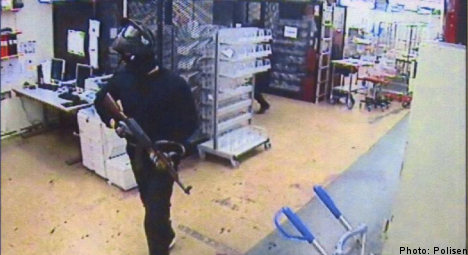The suspects allegedly made off with over 39 million kronor ($5.3 million) after storming the banknote storage facility, which they broke into after being dropped from a helicopter.
Only a small fraction of the amount, less than 100,000 kronor, has been recovered.
The 35-year-old pilot was sentenced by the Södertörn district court to seven years in prison for aggravated robbery, as was a 31-year-old man who had entered the G4S cash depot in Västberga south of Stockholm.
The 39-year-old man thought to be the brains behind the planning of the spectacular caper was convicted of being an accomplice to the heist and given a three-year prison sentence.
Prosecutors had argued for the maximum penalty of ten years in prison.
A 32-year-old man who helped procure mobile phone SIM cards was sentenced to five years in prison as an accessory to aggravated robbery, as was a 33-year-old man who provided the gang with explosives to blast its way into the depot.
The man who rigged a fake traffic accident which was supposed to give the helicopter an alibi was sentenced to two years in prison. And a 38-year-old charged for having recruited the pilot was convicted of protecting a criminal and handed a 1-year prison sentence.
Altogether, seven of the ten men originally charged for their role in the heist were convicted. Two men accused of laying metal caltraps on the road to impede police response to the robbery were released, as was a man charged for having placed fake bombs at a police heliport.
The three men acquitted in the case were released the day after the conclusion of the trial, which ended on September 9th.
Early on September 23, 2009, three masked, armed men were dropped onto the
roof of the G4S banknote facility in southern Stockholm by a stolen helicopter.
The men then smashed a window and blasted their way through the building using explosives before exiting the building several minutes later with sacks of cash.
The robbers carried out the raid with 21 workers present in the centre.
The police were hindered because a bag marked with the word “bomb” had been previously placed at the police helicopter base. They had previously been tipped off by police, in Serbia, where some of the thieves had connections.
The first of the men and a section of the loot were deposited in the Draget district in the Norsborg suburb, before a second drop-off was made at Kånanbadet beach in the Bromma area.
The abandoned helicopter was later found in Skavlöten to the north of Stockholm.
In July, the court charged 10 men on suspicion of aggravated theft and aggravated robbery in connection with heist.
The 35-year-old pilot had a successful career, as well as a house, wife, and children. But behind the veneer of the successful family man, the man hid years of drug abuse. He claimed that he went into relapse on the night of the robbery, resulting in a hazy recollection of the evening’s events.
The 31-year-old who was armed with a machine gun inside the cash depot, together with two other men whom the police have not yet been able to apprehend, confessed shortly after the start of the trial that he is one of the men visible on surveillance camera footage taken from inside the building on the night of the robbery.
The man attributed his August 9th confession, which came after several weeks of steadfast denials, to a sense of compassion for the victims of the heist. However prosecutors argued it likely had to do with the fact that traces of the 31-year-old’s DNA were found in several locations at the crime scene.
The 39-year-old mastermind of the heist was caught after Serbian police recorded conversations he had with a known figure from the Stockholm underworld currently residing in Serbia.
The stylish 39-year-old explained his conversations about recruiting a pilot as having to do with finding a crane operator to carry out work on an illegal building project.
“I called the crane operator ‘the pilot’ because he wore a pilot’s jacket and sunglasses and looked like Tom Cruise in Top Gun,” the 39-year-old told the court.



 Please whitelist us to continue reading.
Please whitelist us to continue reading.
Member comments